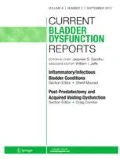Abstract
The purpose of this paper is to discuss overactive bladder (OAB) treatment in the octogenarian female with focus on diagnosis, treatment options, and recent advances relevant to practicing physicians. OAB treatment in the octogenarian female should be individualized. Each patient has her own physical and mental limitations, support system, and treatment expectations. Physicians should assess patients in the overall context of their medical conditions and lifestyle, identify and treat reversible causes, reassess symptoms and continence goals, devise a feasible treatment plan, and follow for symptom improvement. Behavior and lifestyle modifications remain first line for OAB treatment in octogenarians. Age is not a contraindication to medical therapy. OAB procedures are generally low risk and require minimal or no anesthesia. Recent advances include two medications (Myrbetriq™, Oxytrol® for women) and three procedures (sacral neuromodulation, tibial nerve stimulation, onabotulinum toxin).

Similar content being viewed by others
References
Papers of particular interest, published recently, have been highlighted as: • Of importance •• Of major importance
Haylen BT et al. An International Urogynecological Association (IUGA)/International Continence Society (ICS) joint report on the terminology for female pelvic floor dysfunction. Neurourol Urodyn. 2010;29(1):4–20.
Wenger NS, Shekelle PG. Assessing care of vulnerable elders: ACOVE project overview. Ann Intern Med. 2001;135(8 Pt 2):642–6.
Burgio KL et al. Patient satisfaction with stress incontinence surgery. Neurourol Urodyn. 2010;29(8):1403–9.
Tennstedt SL et al. Quality of life after surgery for stress incontinence. Int Urogynecol J Pelvic Floor Dysfunct. 2008;19(12):1631–8.
Wagg, A., et al., Urinary incontinence in frail elderly persons: report from the 5th International Consultation on Incontinence. Neurourol Urodyn, 2014. Review of evidenced-based management of UI in the frail elderly with management recommendations.
Nygaard IE, Lemke JH. Urinary incontinence in rural older women: prevalence, incidence and remission. J Am Geriatr Soc. 1996;44(9):1049–54.
Talley KM et al. Factors associated with toileting disability in older adults without dementia living in residential care facilities. Nurs Res. 2014;63(2):94–104.
Anger JT et al. True prevalence of urinary incontinence among female nursing home residents. Urology. 2006;67(2):281–7.
Gronstedt H et al. Effects of individually tailored physical and daily activities in nursing home residents on activities of daily living, physical performance and physical activity level: a randomized controlled trial. Gerontology. 2013;59(3):220–9.
Vinsnes AG et al. Effect of physical training on urinary incontinence: a randomized parallel group trial in nursing homes. Clin Interv Aging. 2012;7:45–50.
Gillespie LD et al. Interventions for preventing falls in older people living in the community. Cochrane Database Syst Rev. 2012;9, CD007146.
Hu TW et al. Estimated economic costs of overactive bladder in the United States. Urology. 2003;61(6):1123–8.
Caffrey CSM, Park-Lee E. Residents living in residential care facilities: United States, 2010. NCHS data brief, no 91. Hyattsville: National Center for Health Statistics; 2012.
Strehblow C, Smeikal M, Fasching P. Polypharmacy and excessive polypharmacy in octogenarians and older acutely hospitalized patients. Wien Klin Wochenschr. 2014;126(7–8):195–200.
Onder G et al. Strategies to reduce the risk of iatrogenic illness in complex older adults. Age Ageing. 2013;42(3):284–91.
Wagg A et al. Flexible-dose fesoterodine in elderly adults with overactive bladder: results of the randomized, double-blind, placebo-controlled study of fesoterodine in an aging population trial. J Am Geriatr Soc. 2013;61(2):185–93.
Sand PK et al. Once-daily trospium chloride 60 mg extended release in subjects with overactive bladder syndrome who use multiple concomitant medications: post hoc analysis of pooled data from two randomized, placebo-controlled trials. Drugs Aging. 2011;28(2):151–60.
Sand PK et al. Trospium chloride once-daily extended release is efficacious and tolerated in elderly subjects (aged >/= 75 years) with overactive bladder syndrome. BJU Int. 2011;107(4):612–20.
Madhuvrata P et al. Which anticholinergic drug for overactive bladder symptoms in adults. Cochrane Database Syst Rev. 2012;1:CD005429. Review of evidence-based pharmacologic management of UI in adults.
Jayarajan J, Radomski SB. Pharmacotherapy of overactive bladder in adults: a review of efficacy, tolerability, and quality of life. Res Rep Urol. 2013;6:1–16.
Simard C, Tule M. Long-term efficacy of pelvic floor muscle rehabilitation for older women with urinary incontinence. J Obstet Gynaecol Can. 2010;32(12):1163–6.
Gormley EA et al. Diagnosis and treatment of overactive bladder (non-neurogenic) in adults: AUA/SUFU guideline. J Urol. 2012;188(6 Suppl):2455–63. Review of evidenced-based management of OAB in adults including recent treatment advances.
Griebling TL. Sacral nerve stimulation in the elderly. Int Urogynecol J. 2010;21 Suppl 2:S485–9.
Angioli R et al. Success rates, quality of life, and feasibility of sacral nerve stimulation in elderly patients: 1-year follow-up. Int Urogynecol J. 2013;24(5):789–94.
Compliance with Ethics Guidelines
Conflict of Interest
Lisa Rogo-Gupta declares that she has no conflict of interest.
Human and Animal Rights and Informed Consent
This article does not contain any studies with human or animal subjects performed by any of the authors.
Author information
Authors and Affiliations
Corresponding author
Additional information
This article is part of the Topical Collection on Overactive Bladder
Rights and permissions
About this article
Cite this article
Rogo-Gupta, L. Challenges in the Treatment of Overactive Bladder in the Octogenarian Female. Curr Bladder Dysfunct Rep 10, 14–19 (2015). https://doi.org/10.1007/s11884-014-0281-4
Published:
Issue Date:
DOI: https://doi.org/10.1007/s11884-014-0281-4


